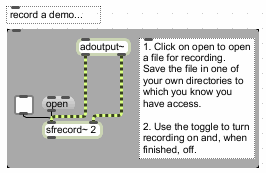rhoadley.net music research software blogs
aru seminars m&t critski focm1a cmc circuit bending mic2b sensor technology comp 3 sonic art major project
youtube vimeo facebook
MaxMSP Tasks
The Synthesis for Max Task
| Task 5 | Name: Breaking Glass Task | Set: w5i | Due: w13i | Weighting: assessable (15%) | Courses: cmc2a |
| Prev Task: Breakbeat-Cutting in MaxMSP | Next Task: Generative Composition Using SC 1 - Generative Composition Using SC 2 | ||||
| Task Summary | All CMC2a tasks | VLE | |||
Investigate some of the ways of using synthesis methods in Max.
To cover:
- Karplus-Strong string synthesis/modelling - Additive, Subtractive synthesis...
Resources
- Tom Hall's synthesis resources
- http://rhoadley.org/courses/tech_resources/max-msp/tasks/MaxSynth/Synthesis-overview.zip
MSP Tutorials
- Tutorial 7: Additive Synthesis
- Tutorial 9: Amplitude Modulation
- Tutorial 10: Vibrato and FM
- Tutorial 11: Frequency Modulation
- Tutorial 21: Using the poly~ Object
MSP Examples
- From Max5/examples/synths/oscsync-advanced.maxpat
- From Max5/examples/synths/FMSynth/X.FM~.maxpat
- From Max5/examples/legacy-examples/synths/fm-surfer-folder/fm-surfer.maxpat
- MaxSynth examples including RissetBell and FMSynthesis
The Task
Finally
|
The Projects
The projects and tasks are designed to help you through the various courses and materials that you'll have to deal with, and also to provide an active and practical element to what could otherwise become a rather dry and technical exercise. Tasks are small exercises - you may be asked to complete one or two per week. Projects are larger and carry a higher percentage of the mark. We will undertake two, three, four or more projects and tasks. The final project is usually an individual choice project, and will be worth significantly more than the others in terms of percentages in your portfolio. We will usually try to set aside a time to perform the projects in a public setting.
